African violets should be repotted about twice a year, or every 5-6 months. One mature, this simply means repotting the plant with some fresh soil, into the same size pot. Never use a pot larger than the plant’s root system–for standards, this usually means about a 4″ pot, for minis and semiminis, a pot no larger than 2 1/2″. Over the course of time, your violet will have lost (or had removed) its older, lower, leaves, forming a “neck”. Repotting is necessary to eliminate this.
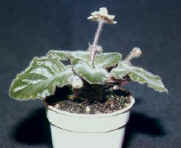
Step 1: African violet with a “neck”. A “neck” is the palm-tree like trunk that appears over time as the lower rows of leaves are removed. A well-grown violet should have its lowest row of leaves growing from the trunk at soil-level. When a neck exists, the lowest row of leaves are well above the soil level and pot rim. By repotting, this unsightly neck can be eliminated. This is easiest to do when done regularly, about every 5-6 months.
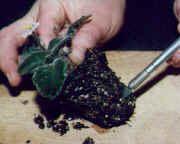
Step 2: Cut-away bottom of root ball. Remove plant from its pot and remove the bottom of the root ball an amount equal to the size of the neck–i.e. if the neck is 1/2″ long, remove 1/2″ from the bottom of the root ball. This is why repotting is best done regularly, before the neck becomes too long. For example, in an extreme case, where a plant has a 2″ neck, we would need to remove 2″ from the bottom of the root ball. If the pot is only 2 1/4″ deep, then nearly the entire root system needs to be removed! By repotting when the neck is still small, very little of the root system needs to be removed, and the plant will show few, if any, ill effects from repotting.
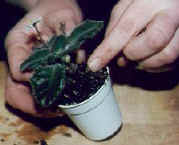
Step 3: Push plant back into same size pot. If this is a mature plant, a larger pot is not needed. Since a bottom portion of the root ball has been removed, the violet can now be pushed lower into the pot. The objective is to lower the plant enough so that the lowest row of leaves is even with the pot rim (i.e. no neck will be visible).
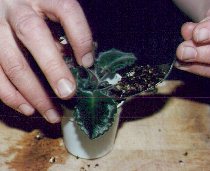
Step 4: Add fresh soil. The violet should now be lower in its pot, so that its lowest row of leaves is level with the pot rim. Add fresh soil, up to the pot rim, covering the neck. The neck will produce new roots into the added soil.
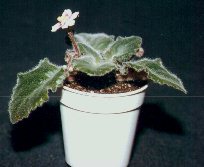
Step 5: The repotted violet. Once repotting is finished, no neck should be visible, and soil level and lower leaves should be even with the pot rim. Label the pot, and lightly water the plant. This is important–until the plant begins to develop new roots into the added soil, it will require a bit less water than before (it has a smaller root system). The more drastic the repotting, the more that this is the case.
Other tips. Improper pot size, poor soil, and too infrequent repotting are probably the most common causes of unhealthy violets amongst inexperienced growers. Though a miniature violet was used in this illustration, the same procedure is used for standard-size varieties. Most standards (unless grown for exhibition), are quite comfortable in a 4″ pot–repotting does not mean continually putting violets into progressively larger pots! Use only a pot as large as the root system–adding soil only benefits the plant if it can develop a root system large enough to use that soil!
A very light, porous, soil-less potting mix is very highly recommended for most growers. If buying a commercially-available mix, judge a soil by its feel not its label! “African violet soils” are often the worstsoil mixes for violets! Look for mixes with plenty of vermiculite and/or perlite (1/3 to 1/2 of mix), with a light, fluffy, consistency. Avoid thick, dark, heavy, soil mixes. Though an experienced grower can grow beautiful plants in almost anything, a light, soil-less mix is much more forgiving of over/underwatering and infrequent repotting and neglect.
91 COMMENTS
- TamaraOctober 5, 2022 10:41 pmI was just gifted two lovely African Violets by an Senior Couple who said they received them as a wedding present 53 years ago. She was originally going to just gift me a clipping from the mother plant but instead decided to give me both as she was in bad health and said her children had no interest in keeping her plants. I would very much like to keep them alive! They are both huge, i am not sure if i can include a photo but both are blooming and have very long, trailing tendrils, or vines? I am new to being a “plant lady” I only started indoor gardening last May with one sad looking tree and now have about 12 plants haha. The violets appear to have gnats so i have covered them loosely with some fine netting. They were looking wilted (she wasn’t sure why, she thought maybe the weather change by the window) but i think maybe they had been over watered? It also looks like they’ve been in the same pot for some time. Experienced gardeners Help! What’s the best coarse of action?Reply
- Violet BarnOctober 10, 2022 10:57 amThe “trailing tendrils” are likely just the result of not being repotting in a very, very, long time. They need to be restarted. See our lesson on this in the plant care pages: https://www.violetbarn.com/plant_care/lessons/restoringrestarting-african-violets/ The wilted appearance, and the gnats, are likely due to it being kept too wet, made worse by the old soil and need of repotting. Repot into a soil not much larger than the root ball, and use a porous soil containing plenty of vermiculite and perlite.
- Kim UnderwoodDecember 21, 2020 7:54 pmThis is my first African violet in 25 years and it took 18 months for it to bloom. I really don’t do much of anything to it, a pinch here and there and only ever repotted it when I bought it. What should I expect? The pot is about 6 inches across and 6 inches tall. The plant is about 4 inches above the rim and the leaves and stems overhang the rim by 1 to 2 inches all the way around. It is just gorgeous but I’m scared that I will bring it to its demise after this beautiful showing.Reply
- Violet BarnDecember 26, 2020 11:21 amYou will need to deal with the neck and repot in fresh soil at some point for it to thrive going forward. Look at this lesson, as well as the lesson on “restoring/restarting” your violet for how-to advice. Violets will live indefinitely if regularly given fresh soil, repotted, and given proper conditions and care.
- Tracy FlavelleOctober 16, 2020 9:55 amI have some very old AV’s that I got from a neighbour. One has bifurcated. How do I separate them, or do I? Both heads have long necks so will b e on transplanting this weekend.
Youe web site is wonderful. Thank you.
Sincerely
TracyReply- Violet BarnOctober 16, 2020 11:00 amYou should separate them, then repot/root into individual pots. Check out the “restarting or restoring” African violets in the lessons section of the plant care pages.
- C.O.February 29, 2020 9:32 amI have 4 “African violets”. Two grow necks and need occasional repotting as described on your site. The other two don’t grow necks. One was my mother’s and is at least 12 years old, so I have only her word to identify it as an African violet. The other I bought from a garden center. Are there “neckless” varieties of African violets, or violet-like plants that can be mistaken for African violets even by professionals – as in a garden shop?Reply
- Violet BarnMarch 6, 2020 2:11 pmAll violets will produce a “neck” over time, some more quickly than others, depending upon how fast they grow and whether any outer, older, leaves are removed.
- BrendaFebruary 25, 2020 9:49 pmIn your potting down a neck, I noticed you did not brush rooting hormone on a scraped neck, as was usually advised twenty years ago. Is this no longer considered “good practice “?

I have my first african violets. Two are thriving beautifully, the other two, well.
I had one plant. I purchased some bowls, really, and them in with just water and potting marbles. They were not happy. I added some soil, then put the marbles back on top. They were happier.
The two pots that are about 8 inches by 3 inches high have done amazing! They are so beautiful. The bowls are clear, so when I see that the leaves are starting to droop, I add just enough water that I see wet soil down to the bottom, just down, not across. The leaves pop back up, the plant flowers. They are thriving.
The two that are/were in 4 inch by 3 inch bowls, not so happy. One of them died. The other is much more tempermental than the ones in bigger bowls. I am going to remove some of the soil to see if that makes a difference, as the proportion seems to be different in the smaller bowl.
I love my plants. I have them in a picture window on my kitchen shelf. I love that they do not outgrow my window. I want to add to my window garden.
In discussing soil being loose, would mixing a orchid mixture to soil be a good idea? Should I be feeding them something? I have not done much, as I don’t want to go overboard, since they are happy and thriving. But I want to keep them that way.
If it’s working, won’t tell you to change. You will need to fertilize at some point. Use a balanced formula and follow directions. Plants don’t care how they are watered, so long as they get the proper amount, when they need it. If your system seems to work, no need to change.
Is it advantagus to dip the leaf cutting in rooting hormone before putting into soil to start a new plant?
African violets are tender tissued so there’s no need for rooting hormone. They will root will without it. If used, do so sparingly.
Hello , I have my Moms plants after she passed and I too am not the best plant person. The necks on these plants are extremely long but the plants continues to flower as if very happy. I know that these need to be repotted but have fear I will harm them. I really need someone to help or support me on these two plants.
If the necks are extremely long, you may need to “restart” the plant. View the lesson on “restoring or restarting an African violet” for a tutorial.